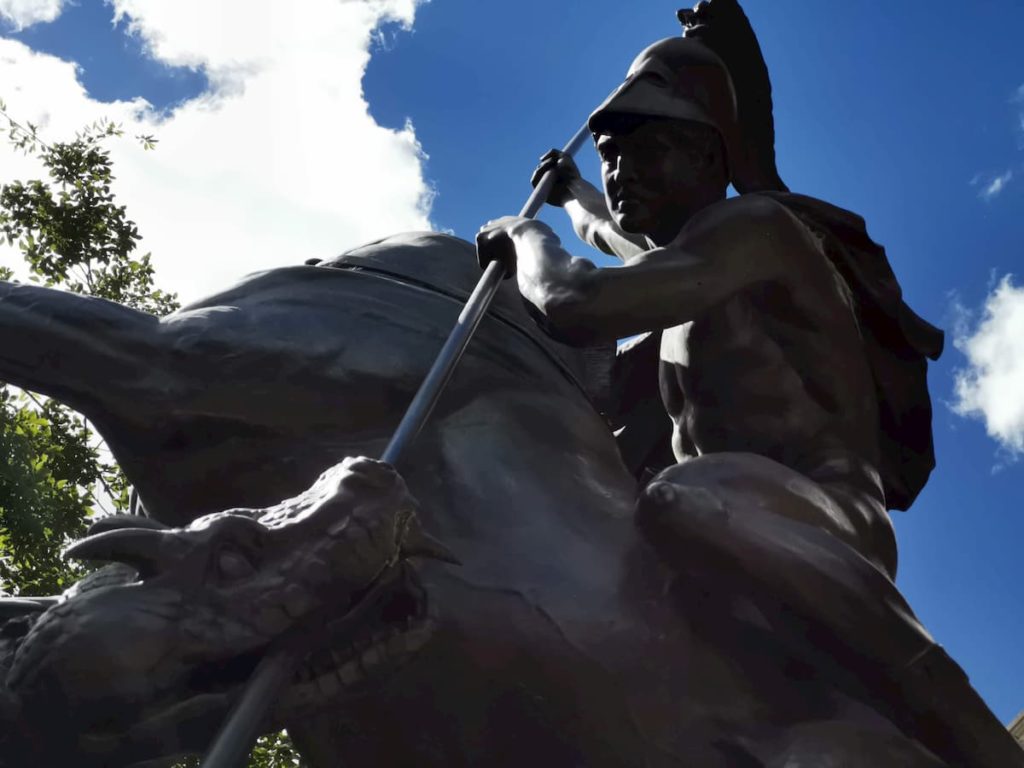The re-opening of the State Library of Victoria allows us to look with fresh eyes on the violence that is at the foundation of the Western worldview.
Walking up the steps of the State Library of Victoria, you are flanked by two heroic figures. To your right is Joan of Arc, standing proud on her steed. But to the left, is a more pensive looking St George, naked on his horse, plunging a spear into the side of a writhing dragon. While his horse is rearing in horror, St George murders this beautiful creature with a cold classical demeanour.
Of the two statues, St George was erected first, in 1889, as “a high point in British Hellenism”. It was a proud symbol of Empire at the bottom of the world.

The spectre of the dragon has defined the nature of heroism in Western mythology. In the canonical Norse saga, “The fire-spewing dragon fully had wasted the fastness of warriors” until Beowulf risks his life to strike the fatal blow. With the future Brexit, we may see the eventual dissolution of the United Kingdom, revealing the blood-red St George Cross that lies at its heart.
The particular English identification with St George occurred around the time of the crusades and the battle against Islam. St George was then a superhero figure of fabled strengths. But the dragon as evil itself has deeper roots in Western culture. It can be traced back to the Semitic religions, such as the Babylonian sea-dragon Tiamat.

Though hopefully, we have moved on from the crusades, the dragon still continues to figure in our moral landscape. The Economist cartoonist KAL regularly represents China as a dragon, threatening tyranny in the region. The image on 14 November this year had Hong Kongers huddled in a boat bearing the word “Freedom”, encircled by a dragon, with the caption “Is it me or are those islands slowly closing in on us…?”

The Chinese threat figured greatly in the development of Australian settlement. Novels such as The Yellow Wave (1895) and the film Australia Calls (1913) conjured the spectre of invasion from the north as a theatre for white Australian manliness. This seems another world to 21st century Australia, where more than half a million Australians are Chinese-born. But attitudes to China itself are turning negative, with a Lowy Institute poll showing that trust in China has dropped 20 points to 32%.
While there may be specific reasons for this, such as heavy-handedness in Hong Kong and Xingjian, there is the danger that we fall back on civilisational fears.
To an extent, China as a nation is, literally, a dragon. It can be found in mosaics as old as 6,000 BC. One hypothesis is that the idea of the dragon came from the discovery of dinosaur bones. In the third century BC, Han Gaozu, the first peasant to take the throne of Emperor, claimed to be fathered by a dragon. Emperors ever after him identified with the dragon as a source of their power and wisdom.
The dragon was more than the singular monarch. There are nine sons of the dragon which ornament a wide range of objects, such as the baimi turtle dragon at the base of columns. Dragons are often depicted with a pearl, representing their place in Buddhism as a symbol of wisdom.
This would make the Chinese dragon seem exceptional. Yet when you look more deeply, you find dragons in almost all cultures, closer to home. The dragon is a key feature of other East Asian cultures such as Korean and Japanese, and is especially important in Vietnam. Elsewhere on the Asian continent, the Hindu Naga snake God is a close relative. Across the Pacific, the Aztecs worshipped the feathered serpent, Quetzalcoatl and the Maori told stories of Taniwha.
In Australia, the dragon is a key part of our social history. As recognised by the generous support by the Victorian state government to replace the Bendigo dragon and welcomed by the traditional dragon artisans of Hong Kong. But it is our Aboriginal cultures where we can find our dragons. The rainbow serpent shares with most sky dragons a key relationship to rain. It is a key story linking sites across the continent.
In his recent book Sand Talk, Tyson Yunkaporta writes about the rainbow serpent as a universal symbol of energy:
we would see him as a wave, a snake, because he is constantly in motion across systems that are constantly in motion and interwoven throughout everything that is, was and will be. There are infinite variations of him in all shapes and sizes throughout the world—wyrms, dragons, ureus and many different names in different regions, taking the shape of the spirit of those places.
There are signs that our appreciation of the dragon is changing. Despite the tragic end, the identification of a dragon with female power in Game of Thrones resuscitated the figure of the female dragon imagined by the English Romantic poets.
But the dragon today has increasing relevance as a symbol of the greatest threat to our existence. With increasing ferocity, climate change wreaks devastation on our planet through massive bushfires, floods and rising sea levels. Already, concepts like the “methane dragon” help us appreciate the danger by reference back to our primal fears.
But this is a monster that can’t be murdered with a spear, no matter how high-tech it might be. In fact, it is the disdain for nature reflected in dragon-slaying which is part of the problem.
The figure of St George reflects a Western attitude of dominion over nature. Efforts to respond to climate changes are stymied by the presumption that new clever technology will solve the problem. But as we find our world vulnerable to ever more destructive weather, particularly floods, we may begin to appreciate nature, like the dragon, is a powerful force that has ultimate power over us and must be respected.
In my daydreams, I imagine Joan of Arc riding over to St George and knocking him off his horse, rescuing the dragon, and thus saving the world. Will Greta Thunberg be the Joan of Arc for our time?

Texts
Arnold, Martin. 2018. Dragon: Fear and Power. Reaktion Books.
Tacon, Paul, and Christopher Chippindale. n.d. “Birth of the Rainbow Serpent in Arnhem Land Rock Art and Oral History.” Archaeology in Oceania. Accessed May 11, 2019.
Wilson, J. Keith. 1990. “Powerful Form and Potent Symbol: The Dragon in Asia.” The Bulletin of the Cleveland Museum of Art 77 (8): 286–323.
Yunkaporta, Tyson. 2019. Sand Talk: How Indigenous Thinking Can Save the World. Text Publishing.

One reply on “Save the dragon!”
As a dragon lover,
I 100% agree.